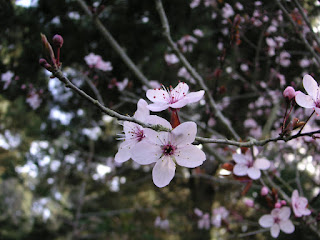blossom
Prunus sp.
Rosaceae
Prunus sp.
Rosaceae
Blossoms in January!?! Since I started Nature ID in 2009, I have been attempting to be mindful that what I observe has its limitations, most likely based on my poor understanding of what is what, or based on when I am actually outside to observe whatever it is that strikes me as unusual, or based on my poor memory. When I first saw these blossoms, I kinda figured this year's mild winter weather must have something to do with it. Is it global warming? Maybe not. I remembered seeing a recent post by Marie at 66 Square Feet about cherry blossoms that are typical in New York City in December, a place that often gets decent snow in the winter (I've been there for work and have had flights cancelled due to too much snow, so I remember the weather well from first-hand experience). I have also commented on John at Sinbad and I on the Loose blog stating that I believe I'm noticing local flowers more this January simply because the weather is warm and I'm actually outside to see the beauty. So then, when I started writing this post and looked through my labels, I found I already have a couple posts of other ornamental blossoms in January. Hmph! Truth be told, blossoms could be about 10 days early this year, but I can't really say or proffer the cause. I now am aware that different species bloom months later like our neighbor's unidentified April blossoms, whereas our native cherry species blooms in June. It's been helpful to have the actual dated records on Nature ID to remind me of the seasonal changes, rather than relying on my fickle memory.
ps 02/11/12 - I originally posted this as cherry blossoms, but I looked at a post from last year by Katie of PhyteClub of Prunus cerasifera, commonly called a cherry plum. Ya! Now I'm confused. How can one tell the difference between cherries and plums when they're blossoming? A quick search online showed me that many other people are confused, too, even in Japan where spring blossoms are regularly celebrated. Some say look for a notch in the petals (notch = cherry, no notch = plum), the shape of the petals (oval = cherry, round = plum, or vice versa), the length of the blossom stem (long = cherry, short or none = plum), the timing of the blooms (late = cherry, early = plum), and all of these have exceptions because there are so many cultivated varieties and crosses. Erg. Two sites I found informative are Quirky Japan Blog and Japan-Guide.com.

6 comments:
Not sure if they grow down your way, but a nice native Prunus that blooms a tad earlier, in mid-to-late March, is Prunus subcordata, Sierra Plum.
We have a few here and there on the peninsula, and they're always nice to see.
I don't believe I've seen anything blooming outside here in January. Of course here in southern Minn. we not that far from the polar bears. :)
Ken, well, that's a Prunus I have not been aware. I'll try to keep my eyes out for them. Looks like they've been reported in the area of Fremont Peak, which we occasionally visit in the Spring.
Mr. T, I'm waiting for pictures of your reported polar bears ;) With your mild winter as well, I figured you'd see something blooming out in January in your neck of the woods.
I just had a flash of the spring cherry blossoms in Japan....so beautiful. There was this one place I went in the mountains where there were so many cherry blossoms and many of them were coming off the trees. The air was snowing with blossoms, with light shining through them. So lovely.
You know what's funny? In my recent, similar post, I was trying to look up climate records for SF, because I was SURE that last year the Prunus started blooming the first week of February, not mid-January. However, checking out my post from last year, I thought the exact same thing. So yeah, I'm right there with you on feeling lucky about keeping a written record!
Katie, I'm thinking I need to change the ID to ornamental plum tree (not that I really know the difference) based on your post last year. It's funny about fuzzy memory of seasons here, because so much of our weather is very similar year round.
Post a Comment